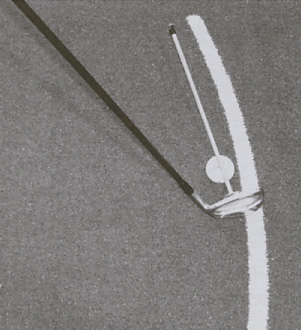There is this thing called physics....and I "recommend" what science says.
I don't recommend something because someone
says they are being "Scientific." I find two or three PHDs and some accurate measurements, and go from there.
Is there a thread that discusses this recommendation in great detail?
You will find NO BETTER short simple "explanation" than "detonum's" above.
But I'll do my best in this thread to smarten you and everyone else up.
As a side note, I am going to give a seminar on this information, on June 1, 2009, for the Tri-State PGA Section.
In particular, I would like to know whether the recommendation is to aim left and/or swing left?
You are going to have to lose the recommendation stuff as per above.

Anyhoo, you can aim anyplace you'd like.
But you have to SWING left of the target. WAY LEFT.
I would also like to know what one is aiming - the club and/or a specific body part?
All the body part alignments, in three dimensions, matter.
But at the end of the day....only the TOP and BOTTOM of the D-Plane matter to the ball.
Finally, I would like to read an "explanation" that explains the "specific" underlying geometry and physics that form the foundation for this recommendation.
Let's start with some terms:
In "dark blue," I will actually do some recommending—the terms I'd suggest folks who teach use for ease of use and learning. The "burnt orange" color is fro the terms TrackMan uses, and the dark green the Golfing Machine usage.
Swing LineHorizontal Swing Plane - Plane Line in "Golfing Machine" terms, the base line of a plane.
In general, this is the "direction" of your swing.
Plane AngleVertical Swing Plane - Plane Angle Basic in "Golfing Machine" terms, the pitch of the roof—so to speak.
Clubhead PathClub Path - The path of the golf clubhead—or if you like to think smaller, sweetspot—through impact, in 2D space relative to the ground...on the Horizontal Axis.
Homer Kelley either mistakenly believed Clubhead Path not to influence ball flight. He believed that the Plane Line to be responsible for that half of the ball-flight equation.
Because the arc that the clubhead travels on is so big—relative to the 3/4th of an inch to 1/2 inch that the clubhead is on the ball—this path is actually nearly a dead straight line.
Attack AngleThe path of the golf clubhead—or if you like to think smaller, sweetspot—through impact, in 2D space relative to the sky...on the Vertcial Axis.
True Path
A brilliant Manzella-ism

that is the actual path of the clubhead in 3D space. Think of it as a combination of Club(head) Path and Attack Angle.
Where the clubface is "pointing" in 2D space relative to the ground...on the Horizontal Axis.
True ClubfaceA another brilliant Manzella-ism

that is where the clubface is actually pointing in 3D space. Think magnetic lie angle tool. Face Angle + Dynamic Loft + Delivered Lie Angle.
The amount of "delivered" loft at impact. You can have a 60° wedge, but if you "de-lofted" it 10°, you had 50° of Dynamic Loft.
Spin Loft
Delivered Loft minus Attack Angle. A 60° wedge, de-lofted to 50° of "Delivered Loft" hit 6° on the way down, would have 56° of "Spin Loft."
D-PlaneA plane angle with three points, the ball, where the TRUE club face is pointing, and where the TRUE path is pointing. Most of the time, the TRUE PATh is on the bottom. The ball will start ~70-85% of the way to the TRUE CLUBFACE, and then curve—UP THE PLANE, toward the TRUE CLUBFACE, until gravity and (or) wind take it out of its journey.
Since the clubhead is striking the ball on the way down with an iron—approximately 6° with a 60° wedge, 5° with a pitching wedge, about 3° with a long iron—the clubhead is STILL TRAVELING
downward,
outward, and
forward on the face of the plane (Vertical Swing Plane).
So, wherever that "Plane" is pointing (Horizontal Swing Plane), the TRUE PATH of that clubhead will be down and out to that line.
With a Driver—which you do not want to hit on the way down, but you
can—when it is swung with a 45° Vertical Swing Plane (plane angle), the clubhead is traveling 1° out for every one degree down.
With a club swung at 60°—the club is moving ~0.56° out for every one degree down.
So....
Here is an example straight ball:
(with corrected math)
An 8-iron from 150 yards....
Lets say you hit down 4° at 60° with a 8-iron.....you are also hitting "out" ~2.67°
And since 1° at 100 yards is about ~1.75 yards....
And you hit your 8-iron 150 yards....
You need to AIM and (or) SWING ~2.67° at 150 yards....which is ~7 yards left of the target!
That will give you the bottom of the D-Plane on the target line, and you now have to have the
CLUBFACE square to the target, or in this case 2.67° open to the "Plane Line."
Pretty cool, eh?
And by the way, the "HOOKFACE" is simply the sweetspot being behind the center line.
All the above COULDN'T CARE LESS about it.
0.222222 x how many degrees less than 90°

